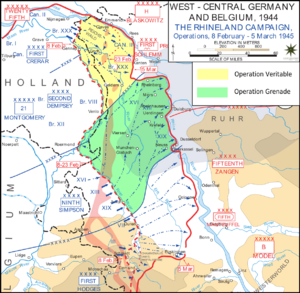Operation Grenade facts for kids
Quick facts for kids Operation Grenade (Battle of the Reichswald) |
|||||||
|---|---|---|---|---|---|---|---|
| Part of the Western Allied invasion of Germany in the Western Front of the European theatre of World War II | |||||||
 Operations Veritable and Blockbuster (yellow) and Grenade (green) |
|||||||
|
|||||||
| Belligerents | |||||||
| Commanders and leaders | |||||||
| Strength | |||||||
| 380,000 1,400 tanks 2,070 guns 375 aircraft |
54,000 180 tanks |
||||||
| Casualties and losses | |||||||
| 1,330 killed Total: 7,478 |
29,739 captured 16,000 other casualties (US estimate) Total: 45,739 |
||||||
Operation Grenade was an important military action during World War II. It happened in February 1945. This operation involved the U.S. Ninth Army crossing the Roer River in Germany.
The crossing was a key part of the Western Allied invasion of Germany. It marked the beginning of the Allies pushing into Germany from the west. The U.S. Ninth Army was led by Lieutenant General William Hood Simpson.
Contents
What Was Operation Grenade?
Operation Grenade was a major military plan. It aimed to cross the Roer River in Germany. This river is located between the cities of Roermond and Düren. The operation was a big step in the Allied forces' advance into Germany.
The Plan to Cross the Roer River
On February 9, 1945, the U.S. Ninth Army was ready. Their job was to cross the Roer River. They were working with the British and Canadian forces. These forces were part of the 21st Army Group, led by Field Marshal Bernard Montgomery.
The plan was for the Ninth Army to meet up with the First Canadian Army. The Canadian Army was led by Lieutenant-General Harry Crerar. They were coming from the Nijmegen area in the Netherlands. Their own operation was called Operation Veritable, which had started a day earlier.
Germany's Flooding Defense
The Germans knew the Allies were coming. They tried to stop the American advance. They did this by opening the sluice gates of dams upstream. Sluice gates are like large doors that control water flow. When opened, they release a lot of water.
This action caused the Roer River to flood. The water level rose too high for the American soldiers to cross safely. The flooding stopped the U.S. Ninth Army from moving forward as planned. The Allies had expected the Germans might do this. They hoped to capture the dams in time.
Hitler's Orders and German Commanders
The river stayed flooded for two weeks. During this time, Adolf Hitler gave strict orders. He told his commanders not to pull back their troops. He wanted them to fight where they were, even with the flooding.
The German forces in this area included the 15th Army. It was commanded by Gustav-Adolf von Zangen. The 1st Parachute Army was also there. It was led by Alfred Schlemm.
Crossing the River and Victory
Finally, on February 23, the U.S. Ninth Army could cross the Roer River. By this time, other Allied forces were also getting close to the Rhine River. The Rhine was another major river in Germany.
During Operation Grenade and other related operations, the German forces lost many soldiers. About 90,000 German soldiers were lost. More than 50,000 of them became prisoners of war (POWs). POWs are soldiers captured by the enemy. The Allied forces had about 23,000 casualties. This means about 23,000 Allied soldiers were killed, wounded, or missing. Operation Grenade was a success for the Allies.

